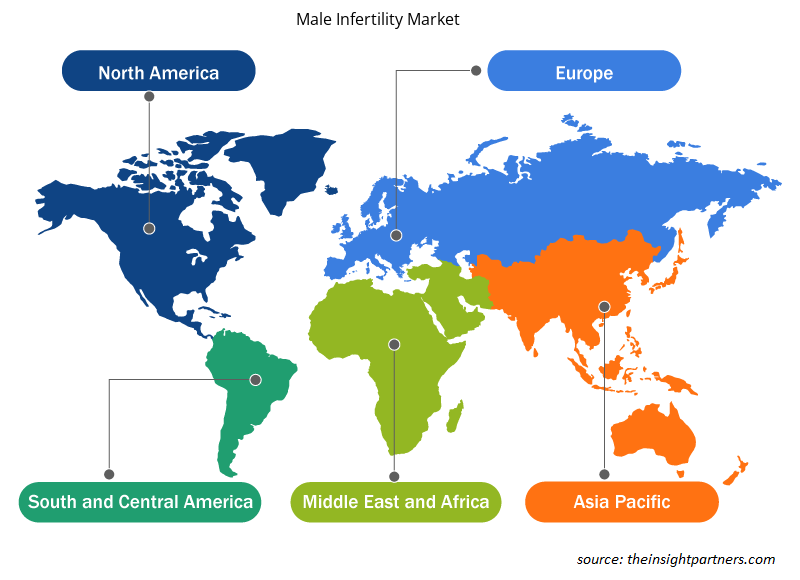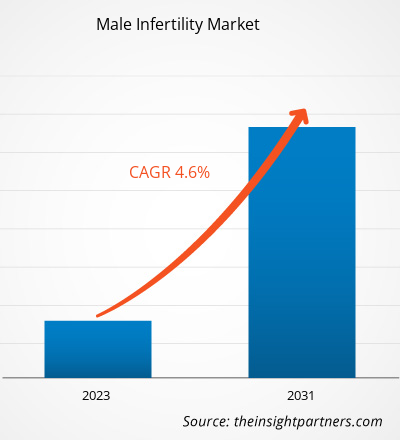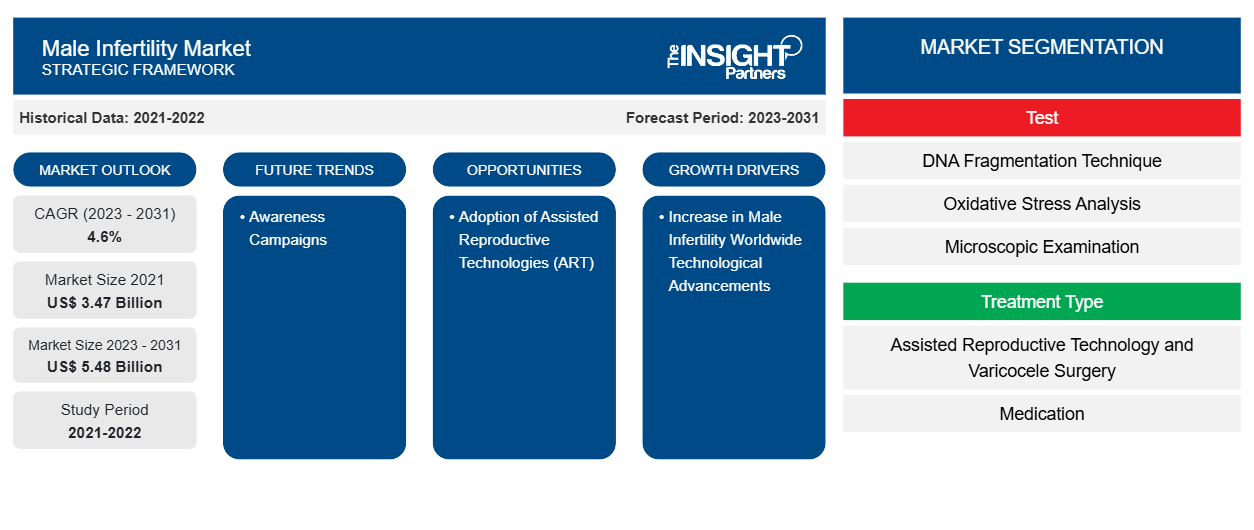La dimensione del mercato dell'infertilità maschile nel 2021 era di 3,47 miliardi di dollari USA e si prevede che raggiungerà i 5,48 miliardi di dollari USA entro il 2031 dai XX miliardi di dollari USA nel 2023. Si prevede che il mercato registrerà un CAGR del 4,6% nel 2023-2031. È probabile che l'adozione di tecnologie di riproduzione assistita (ART) rimanga una delle principali tendenze del mercato dell'infertilità maschile.
Analisi del mercato dell'infertilità maschile
Il mercato dell'infertilità maschile è in crescita a causa dell'aumento dei tassi di infertilità, dell'adozione diffusa della tecnologia di riproduzione assistita (ART) e dei progressi tecnologici nell'ART, tra gli altri fattori. Inoltre, l'aumento dei livelli di stress, l'obesità, il fumo e l'uso di alcol sono tutti fattori che contribuiscono all'infertilità maschile. Inoltre, una maggiore consapevolezza, una maggiore spesa in R&S e il cambiamento degli stili di vita stanno tutti guidando il mercato dell'infertilità maschile.
Panoramica del mercato dell'infertilità maschile
L'infertilità maschile è un problema importante nella società moderna. L'infertilità è sempre stata considerata un problema femminile. Tuttavia, gli uomini rappresentano quasi la metà di tutti i casi di infertilità. L'infertilità negli uomini è più comunemente causata da problemi come la diminuzione del numero di spermatozoi, la diminuzione dei livelli di testosterone e l'aumento dei tassi di disfunzione erettile e cancro ai testicoli. Inoltre, è stato scoperto che l'inquinamento influenza la fertilità degli uomini, in particolare la qualità dello sperma.
Personalizza questo report in base alle tue esigenze
Riceverai la personalizzazione gratuita di qualsiasi report, comprese parti di questo report, o analisi a livello nazionale, pacchetto dati Excel, oltre a usufruire di grandi offerte e sconti per start-up e università
-
Scopri le principali tendenze di mercato in questo rapporto.Questo campione GRATUITO includerà analisi di dati che spaziano dalle tendenze di mercato alle stime e alle previsioni.
Driver e opportunità del mercato dell'infertilità maschile
L'aumento dell'infertilità maschile in tutto il mondo favorisce la crescita del mercato
L'infertilità maschile si riferisce all'incapacità degli uomini di causare una gravidanza in una femmina fertile. L'infertilità è comunemente causata da fattori come la carenza di sperma e la qualità dello sperma. L'infertilità negli uomini è un problema diffuso a livello globale con percentuali che variano da una regione all'altra. Secondo un articolo pubblicato nel 2023 dai National Institutes of Health (NIH), l'infertilità maschile colpisce il 7% della popolazione maschile mondiale. Inoltre, i tassi di infertilità tra gli uomini sono risultati più alti in Africa e nell'Europa orientale.
Campagne di sensibilizzazione
L'International Reproductive Health Education Collaboration (IRHEC), precedentemente nota come International Fertility Education Initiative, è stata fondata nel 2021. Il suo scopo è promuovere la consapevolezza della fertilità attraverso l'istruzione. I materiali didattici che promuovono efficacemente l'alfabetizzazione o la consapevolezza della salute della fertilità sono fondamentali per prendere decisioni riproduttive informate, prevenire e gestire la subfertilità e l'infertilità.IRHEC), formerly known as the International Fertility Education Initiative, was established in 2021. Its purpose is to promote fertility awareness through education. Educational materials that effectively promote fertility health literacy or awareness are critical for making informed reproductive decisions, preventing and managing subfertility, and infertility.
Analisi della segmentazione del rapporto di mercato sull'infertilità maschile
I segmenti chiave che hanno contribuito alla derivazione dell'analisi di mercato dell'infertilità maschile sono test, tipo di trattamento, canale di distribuzione e utente finale.
- Sulla base dei test, il mercato dell'infertilità maschile è suddiviso in tecnica di frammentazione del DNA, analisi dello stress ossidativo, esame microscopico, agglutinazione dello sperma, analisi del liquido seminale assistita da computer, test di penetrazione dello sperma e altri. Il segmento della tecnica di frammentazione del DNA ha detenuto una quota di mercato maggiore nel 2023.
- Per tipo di trattamento, il mercato è diviso in tecnologia di riproduzione assistita e chirurgia del varicocele, e farmaci. Il segmento della tecnologia di riproduzione assistita e della chirurgia del varicocele ha detenuto la quota maggiore del mercato nel 2023.
- Per canale di distribuzione, il mercato è segmentato in farmacie ospedaliere, farmacie e drugstore, farmacie online. Il segmento delle farmacie ospedaliere ha detenuto la quota maggiore del mercato nel 2023.
- In termini di utente finale, il mercato è diviso in ospedali e cliniche, centri per la fertilità, istituti di ricerca e altri utenti finali. Il segmento dei centri per la fertilità ha dominato il mercato nel 2023.
Analisi della quota di mercato dell'infertilità maschile per area geografica
L'ambito geografico del rapporto sul mercato dell'infertilità maschile è suddiviso principalmente in cinque regioni: Nord America, Asia Pacifico, Europa, Medio Oriente e Africa, Sud e Centro America.
Il Nord America ha dominato il mercato dell'infertilità maschile. Il crescente consumo di alcol e droghe, l'aumento dei livelli di stress, l'obesità, il fumo e le tossine ambientali sono tra i pochi fattori che si prevede accelereranno la crescita del mercato dell'infertilità maschile del Nord America. Inoltre, si prevede che la crescente consapevolezza e la riduzione del nervosismo tra le persone riguardo alla malattia guideranno la domanda di trattamento dell'infertilità maschile durante il periodo di studio.
Approfondimenti regionali sul mercato dell'infertilità maschile
Le tendenze regionali e i fattori che influenzano il mercato dell'infertilità maschile durante il periodo di previsione sono stati ampiamente spiegati dagli analisti di Insight Partners. Questa sezione discute anche i segmenti e la geografia del mercato dell'infertilità maschile in Nord America, Europa, Asia Pacifico, Medio Oriente e Africa e America meridionale e centrale.

- Ottieni i dati specifici regionali per il mercato dell'infertilità maschile
Ambito del rapporto sul mercato dell'infertilità maschile
| Attributo del report | Dettagli |
|---|---|
| Dimensioni del mercato nel 2021 | 3,47 miliardi di dollari USA |
| Dimensioni del mercato entro il 2031 | 5,48 miliardi di dollari USA |
| CAGR globale (2023-2031) | 4,6% |
| Dati storici | 2021-2022 |
| Periodo di previsione | 2023-2031 |
| Segmenti coperti |
Per prova
|
| Regioni e Paesi coperti |
America del Nord
|
| Leader di mercato e profili aziendali chiave |
|
Densità degli attori del mercato dell'infertilità maschile: comprendere il suo impatto sulle dinamiche aziendali
Il mercato dell'infertilità maschile sta crescendo rapidamente, spinto dalla crescente domanda degli utenti finali dovuta a fattori quali l'evoluzione delle preferenze dei consumatori, i progressi tecnologici e una maggiore consapevolezza dei benefici del prodotto. Con l'aumento della domanda, le aziende stanno ampliando le loro offerte, innovando per soddisfare le esigenze dei consumatori e capitalizzando sulle tendenze emergenti, il che alimenta ulteriormente la crescita del mercato.
La densità degli operatori di mercato si riferisce alla distribuzione di aziende o società che operano in un particolare mercato o settore. Indica quanti concorrenti (operatori di mercato) sono presenti in un dato spazio di mercato in relazione alle sue dimensioni o al valore di mercato totale.
Le principali aziende che operano nel mercato dell'infertilità maschile sono:
- MERCK KGaA,
- Sanofi,
- La Bayer AG,
- Endo Pharmaceuticals Inc.,
- Diagnostica SCSA, Inc.,
- Soluzioni per l'andrologia,
Disclaimer : le aziende elencate sopra non sono classificate secondo un ordine particolare.

- Ottieni una panoramica dei principali attori del mercato dell'infertilità maschile
Notizie e sviluppi recenti sul mercato dell'infertilità maschile
Il mercato dell'infertilità maschile viene valutato raccogliendo dati qualitativi e quantitativi post-ricerca primaria e secondaria, che includono importanti pubblicazioni aziendali, dati associativi e database. Di seguito è riportato un elenco degli sviluppi nel mercato dell'infertilità maschile:
- Sidra Medicine ha lanciato una nuova clinica per l'infertilità maschile come parte della sua espansione dei servizi privati di medicina riproduttiva in Qatar. (Fonte: Sidra Medicine, Newsroom, 2022)
- Merck, azienda leader nel campo della scienza e della tecnologia, ha annunciato oggi che la Commissione Europea (CE) ha concesso l'autorizzazione all'immissione in commercio (MA) per la sua nuova penna GONAL-f (follitropina alfa) da 150 UI. Ciò significa che Merck offre ora una gamma ancora più completa di penne best-in-class, supportando i pazienti dall'inizio alla fine del loro ciclo di stimolazione della fertilità, quando sono necessarie dosi inferiori. (Fonte: Merck KGaA, comunicato stampa, 2020)
Copertura e risultati del rapporto sul mercato dell'infertilità maschile
Il rapporto "Dimensioni e previsioni del mercato dell'infertilità maschile (2021-2031)" fornisce un'analisi dettagliata del mercato che copre le seguenti aree:
- Dimensioni e previsioni del mercato a livello globale, regionale e nazionale per tutti i segmenti di mercato chiave coperti dall'ambito
- Dinamiche di mercato come fattori trainanti, vincoli e opportunità chiave
- Principali tendenze future
- Analisi dettagliata delle cinque forze PEST/Porter e SWOT
- Analisi di mercato globale e regionale che copre le principali tendenze di mercato, i principali attori, le normative e gli sviluppi recenti del mercato
- Analisi del panorama industriale e della concorrenza che copre la concentrazione del mercato, l'analisi della mappa di calore, i principali attori e gli sviluppi recenti
- Profili aziendali dettagliati
- Analisi storica (2 anni), anno base, previsione (7 anni) con CAGR
- Analisi PEST e SWOT
- Valore/volume delle dimensioni del mercato - Globale, Regionale, Nazionale
- Industria e panorama competitivo
- Set di dati Excel
Report recenti
Testimonianze
Motivo dell'acquisto
- Processo decisionale informato
- Comprensione delle dinamiche di mercato
- Analisi competitiva
- Analisi dei clienti
- Previsioni di mercato
- Mitigazione del rischio
- Pianificazione strategica
- Giustificazione degli investimenti
- Identificazione dei mercati emergenti
- Miglioramento delle strategie di marketing
- Aumento dell'efficienza operativa
- Allineamento alle tendenze normative























 Ottieni un campione gratuito per - Mercato dell'infertilità maschile
Ottieni un campione gratuito per - Mercato dell'infertilità maschile